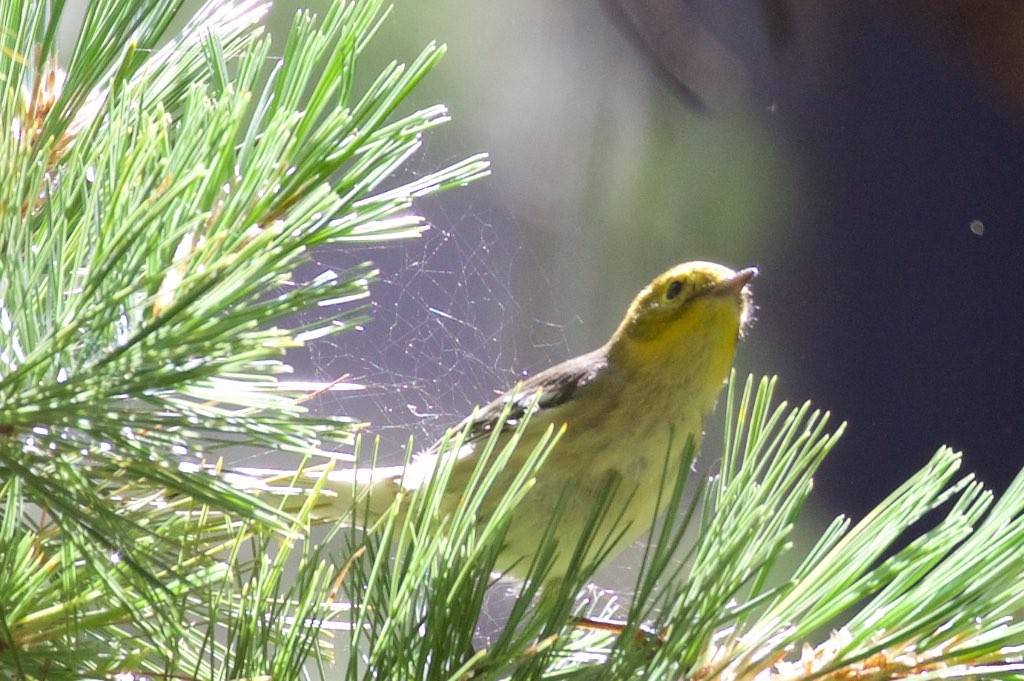Hermit Warbler
A species of Setophaga Warblers Scientific name : Setophaga occidentalis Genus : Setophaga Warblers
Hermit Warbler, A species of Setophaga Warblers
Botanical name: Setophaga occidentalis
Genus: Setophaga Warblers
Content
Description General Info
Description
The hermit warbler (Setophaga occidentalis) is a small perching bird. It is a species of New World warbler. Measurements: Length: 5.5 in (14 cm) Weight: 0.3-0.5 oz (9-13 g) Wingspan: 7.9 in (20 cm) Hermit warblers are dark gray in coloration on top, and white below, and their flanks are streaked with black. The wings have two diagonal white wing bars. The majority of the hermit warbler's head is yellow, and males have a dark black throat, while females have much less black on their throat bib and immature birds have no black throat. Hermit warblers are common, but incredibly shy, birds that dwell in open coniferous forests. Their summer breeding range is the majority of the west coast of the United States up to Washington. They will sometimes winter in south-west California, but they are migratory and will winter in Central America as far south as Panama. Nests are neat and cup-shaped, constructed from stems, grass, twigs, and pine needles positioned near the tip of a branch high in a conifer tree. The female will lay between 3 and 5 eggs, which are white in color and heavily spotted with brown and lilac speckles. Other incubation and nesting habits are mostly unknown. Like most warblers the hermit warbler eats a strict diet of insects and spiders, and can often be found hanging upside-down from the ends of conifer branches, like a chickadee, probing for food. 
Size
13 cm (5 in)
Life Expectancy
4-9 years
Nest Placement
Tree
Clutch Size
4 - 5 eggs
Feeding Habits
Hermit Warbler primarily consume insects and spiders. They forage in the canopy, with sexual dimorphism in foraging height. Their most active foraging occurs in morning and late afternoon, picking prey from foliage by hopping or walking and occasionally hovering, but seldom chasing. Diet includes moths, butterflies, caterpillars, beetles, flies, wasps, stone flies, bugs, spiders, and some fruit, particularly in winter. They also consume 'honeydew' from scale insects and aphids.
Habitat
Hermit Warbler inhabit mature coniferous forests in mountainous Pacific coastal regions, predominantly in the Coast, Cascade, and Sierra Nevada ranges. They favor canopies with a variety of conifers, such as pines and firs, occupying upper tree sections. While adaptive during migration, their preferred winter habitats include high-altitude pine and cloud forests in Central America, and oak and pine woodlands in California.
Nest Behavior
The female of hermit Warbler species handles nest construction and may do it alone, laying eggs in a well-concealed location. The intricacies of egg-laying patterns, timing for nest building, and parental care after the eggs hatch are critical for their offspring's survival.
Nest Characteristics
Hermit Warbler's nest is usually on a high, horizontal limb, hidden by leaves. A self-built cup by the female, it combines twigs, roots, moss, bark, pine needles, plant fibers, hair, feathers, and plant down, held with spiderweb. It's about 3.9 inches wide, 2.1 inches tall, with a 2-inch-wide, 1.2-inch-deep cup.
Dite type
Insectivorous
General Info
Feeding Habits
Bird food type
Bird Feeder Type

Small Tube Feeder
Behavior
Hermit Warbler demonstrate secretive breeding behaviors, often within the concealment of high canopies, making their courtship practices somewhat enigmatic. They exhibit a strong pair bond during the breeding season, with males foraging in proximity to females until egg-laying concludes. Typically solitary in their foraging endeavors, hermit Warbler display territorial aggression towards others of their kind. Both sexes invest in incubation and feeding of chicks, with family units sometimes merging into mixed-species foraging groups post-fledging. They display gregariousness during migration and in wintering habitats, often joining diverse avian assemblages for foraging activities.
Species Status
Not globally threatened.
Scientific Classification
Phylum
Chordates Class
Birds Order
Perching birds Family
New world warblers Genus
Setophaga Warblers Species
Hermit Warbler 